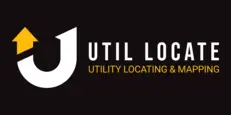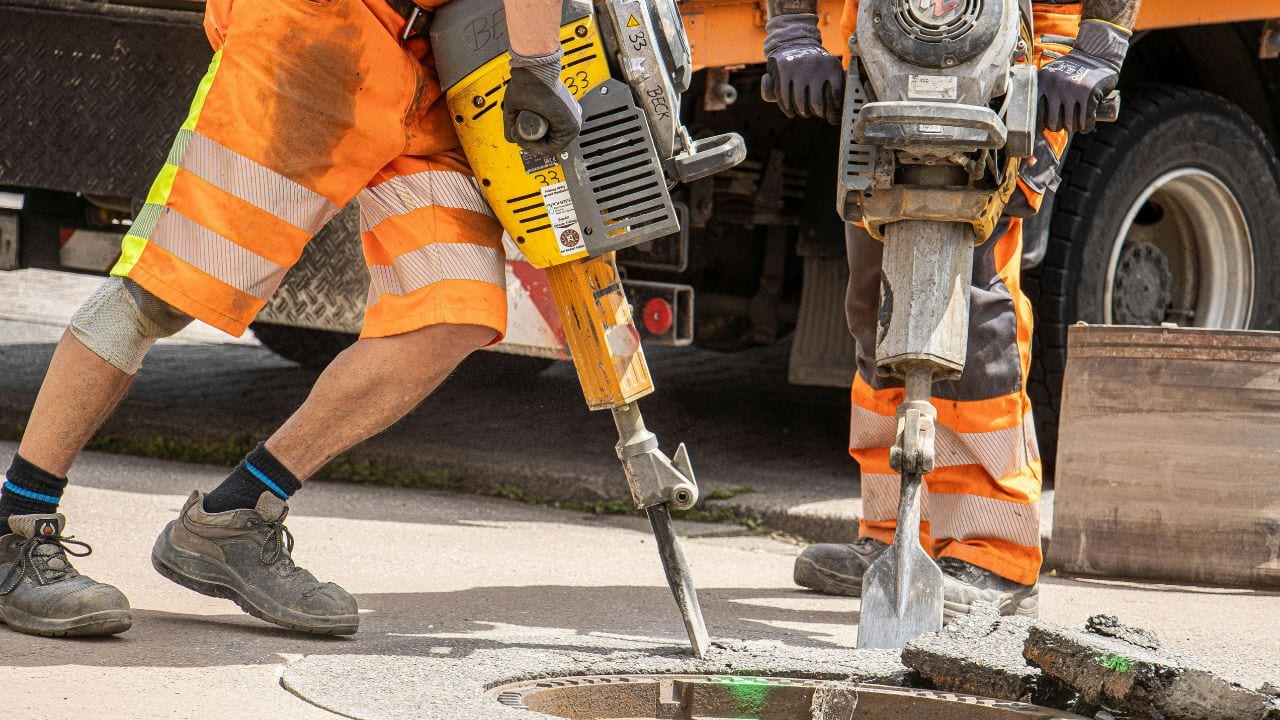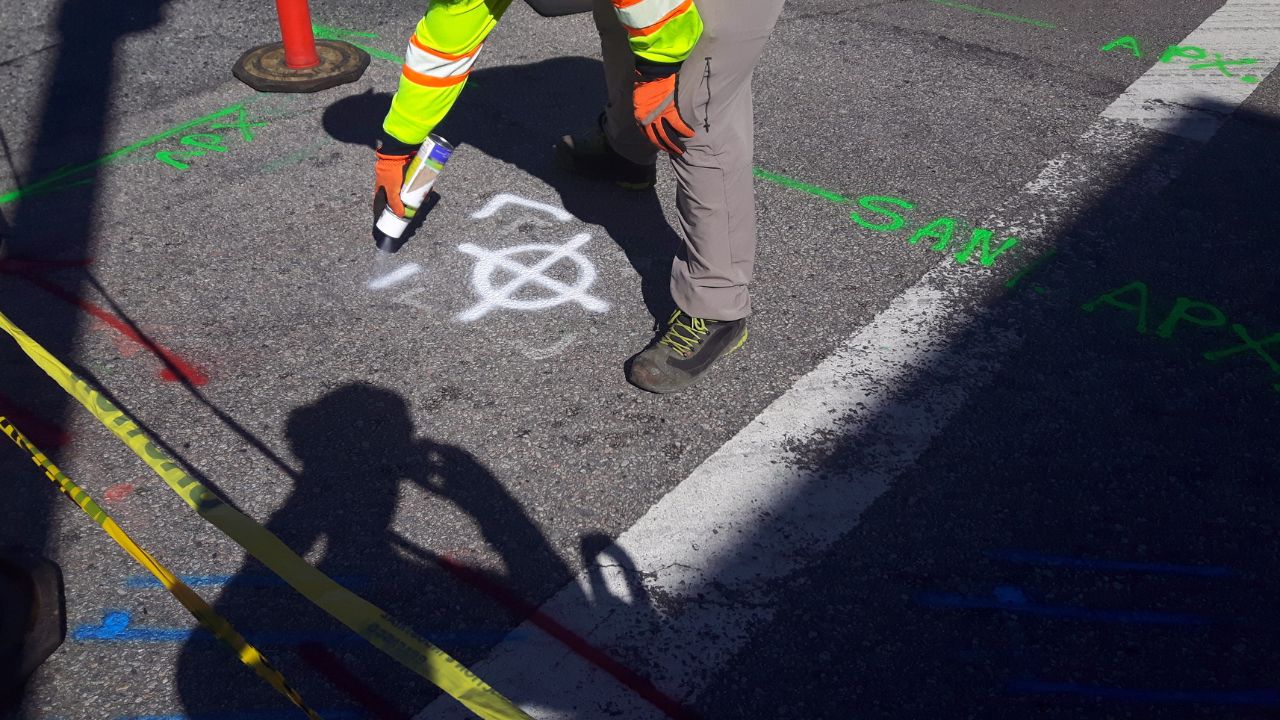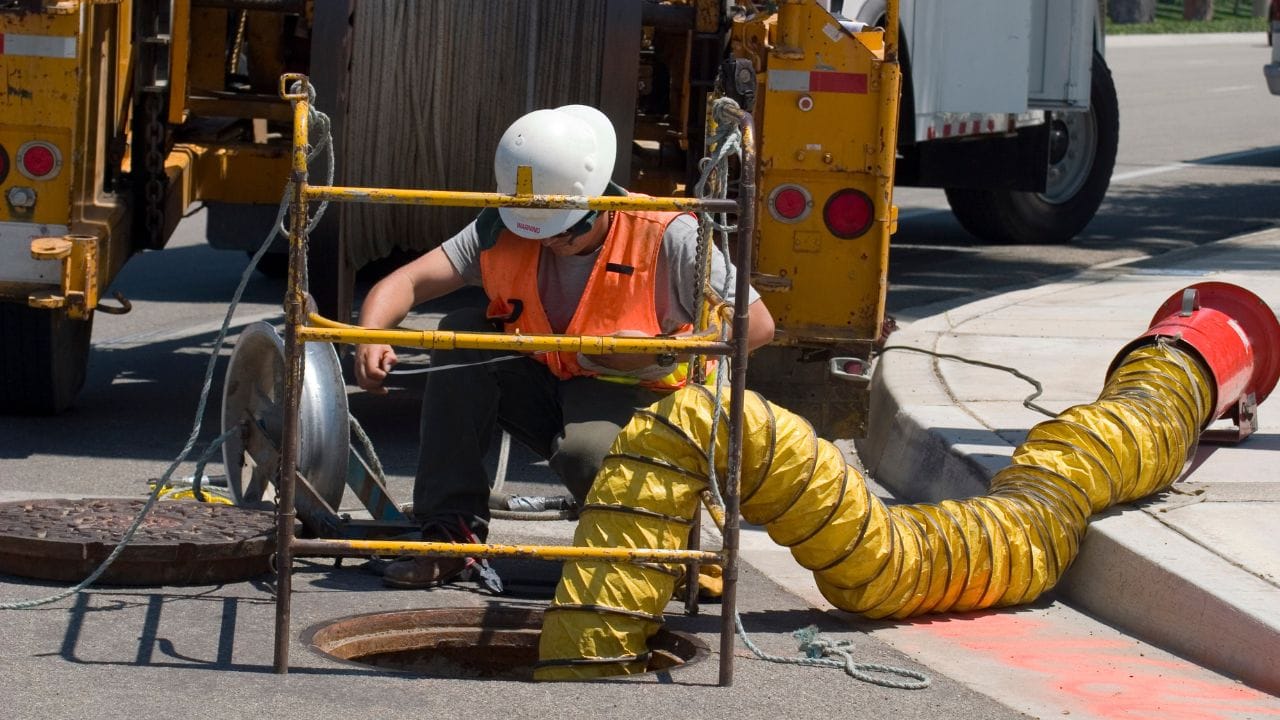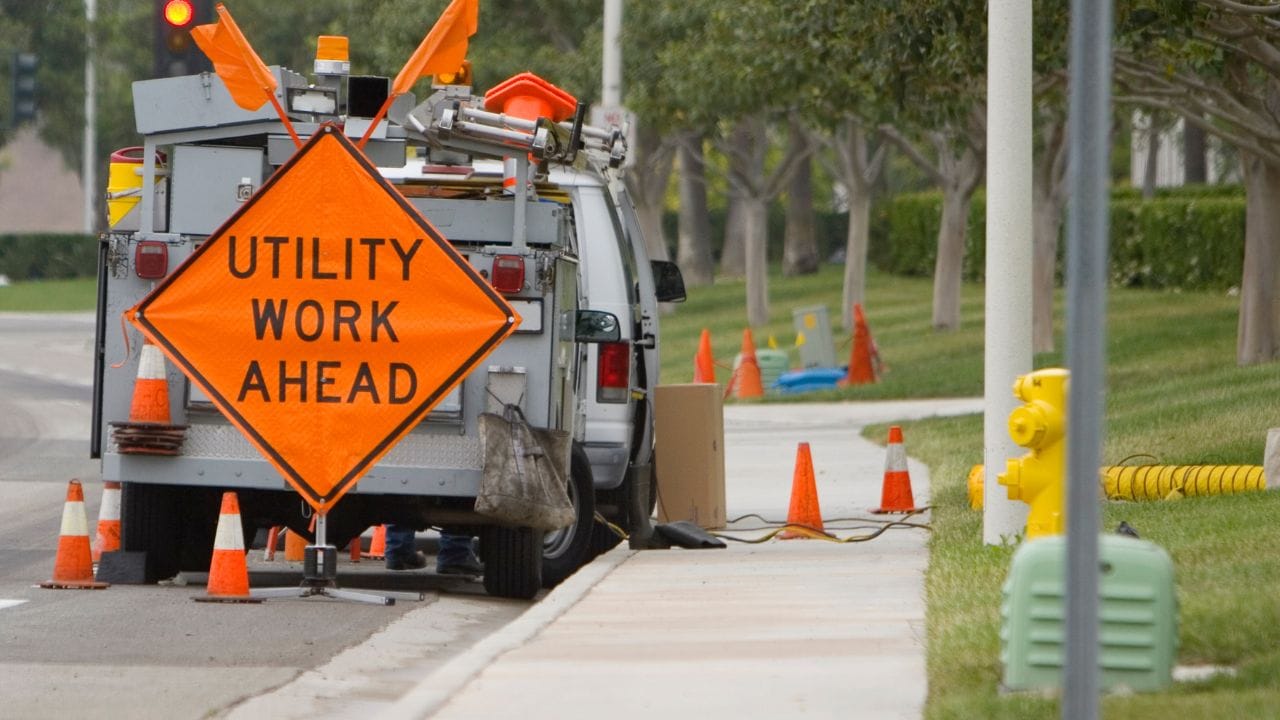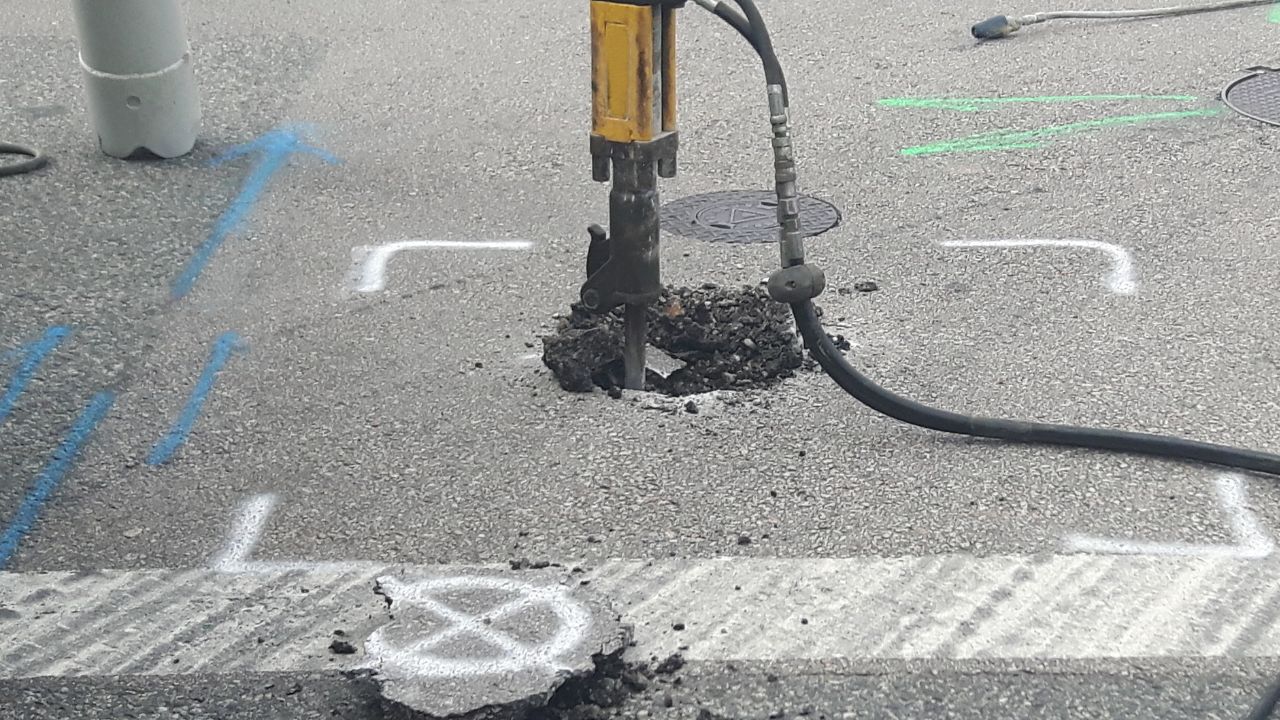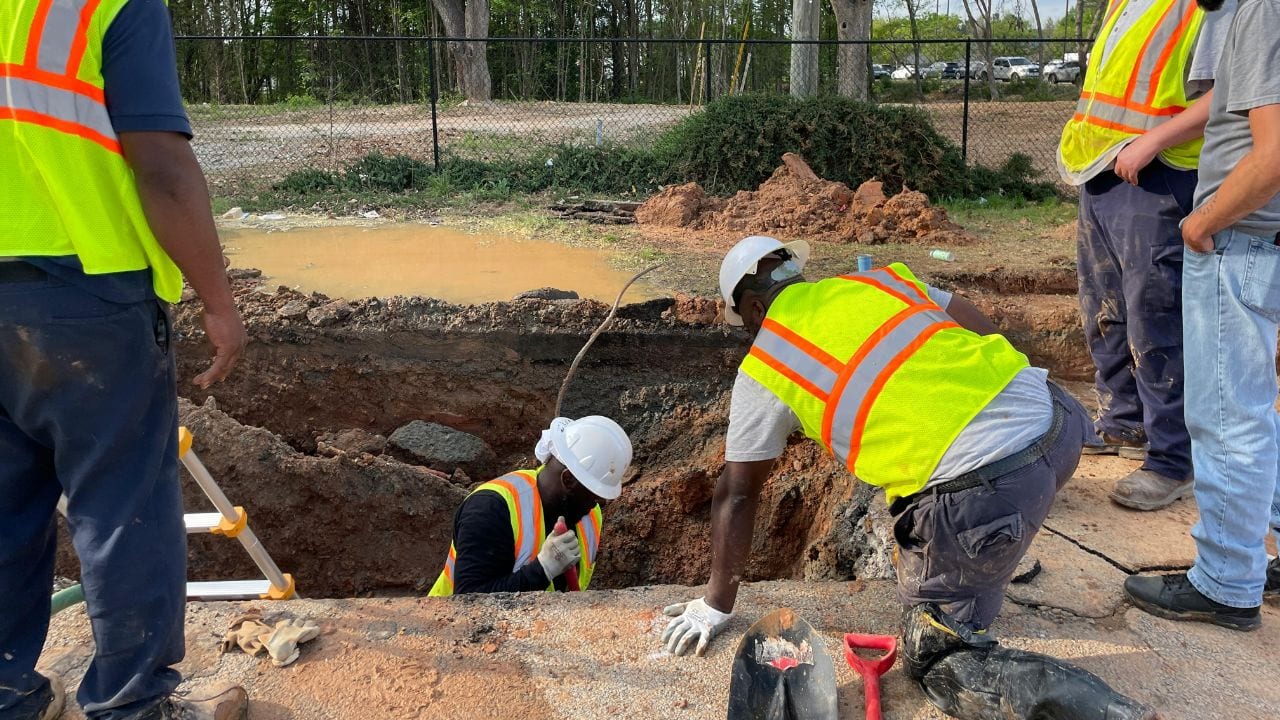Key Takeaways:
- The top 6 utility damage causes account for 76% of all strikes for three consecutive years—yet every cause has documented preventive solutions costing far less than the $56,000 average strike
- Professional SUE delivers $4.62 saved per $1.00 invested, with state DOT results ranging from 412% to 663% ROI—only 3 of 71 FHWA/Purdue projects showed negative returns
- Orange County permit complexity demands 7-10 day 811 lead times vs. 2-day minimums: Caltrans D12 requires 6-16 weeks, traffic restrictions compress work windows, and 50% of excavators face start delays
- Vacuum excavation achieves 0.2% damage rate vs. 53.9% mechanical excavation and 20.5% hand tools while delivering 10x speed and 4x cost savings—18 pits/day productivity vs. 4 pits/day with alternative methods
- 60% of U.S. utility lines are private and NOT located by free 811 service—comprehensive projects require both DigAlert public locating and private locators for $500-$30K to map complete subsurface infrastructure
Orange County projects operate under exceptional timeline pressure. Dense regulatory requirements from multiple jurisdictions—county, Caltrans District 12, OCTA, and municipal agencies—create approval bottlenecks at every phase. Tight construction windows dictated by traffic restrictions, environmental reviews, and permit coordination leave zero schedule buffer. Subcontractor dependencies compound these pressures: when one trade stops, cascading delays ripple through the entire project.
Table: Top Causes of Construction Delays in Orange County
| Cause | Frequency | Average Time Lost | Preventive Action |
| Excavator failed to notify 811 | Part of 76% (Top 6) | 8-12 weeks per strike | Submit DigAlert ticket 7-10 days before excavation |
| Locating/marking error by the facility owner | Part of 76% (Top 6) | 50% start delays | Hire a private locator for a verification scan |
| Excavation practices (hand tool/vacuum not used) | Part of 76% (Top 6) | 8-12 weeks per strike | Use vacuum excavation in tolerance zones |
| Notification practices (incomplete delineation) | Part of 76% (Top 6) | 2+ day re-mark delay | White-line the entire dig area before calling 811 |
| Locating practices (inaccurate marks, missed utilities) | Part of 76% (Top 6) | 8-12 weeks per strike | Budget for QL-B geophysics + QL-A test holes |
| One-call center performance issues | Part of 76% (Top 6) | Variable delays | Build 7-10 day lead time vs. 2-day minimum |
| Cost Impact | 192,745 strikes/year (US) | Crew idle: $96/hr | ROI: $4.62 saved per $1 spent on SUE |
Source: CGA DIRT Report 2023 (3 consecutive years), Finch study, 12-state analysis
Underground utility conflicts stand out as the most preventable delay source. The six root causes above account for 76% of all utility damages for three consecutive years—yet every one has a documented preventive solution. Professional locating eliminates 50% start delay probability caused by late utility responses, while proper excavation practices reduce strike rates from 53.9% (mechanical) and 20.5% (hand tools) to just 0.2% with vacuum excavation.
Local Factors Increasing Delay Risk:
- Permit Processing Timelines: Orange County municipalities require 2-12 weeks, depending on project scope, traffic impacts, and CEQA environmental review requirements
- Caltrans District 12 Encroachment Permits: 6-16 weeks standard processing; 3-6 months for complex projects requiring environmental or traffic studies
- Traffic Control Restrictions: Peak hours 6-9 AM and 3-7 PM prohibit lane closures on major routes—compressing work windows and extending project duration
- Advanced Signing Requirements: Minimum 48-72 hours required before implementing lane closures—delaying response to field conditions
- Multi-Agency Coordination: Recent example: Laguna Canyon Road project experienced 56% cost escalation, partly attributed to coordination complexity across utilities, environmental agencies, and multiple jurisdictions
- High-Traffic Corridor Challenges: OCTA’s major projects face persistent coordination difficulties with Caltrans D12 and utility conflicts in congested rights-of-way, including I-5, SR-73, SR-91, and I-405 corridors
What Is Utility Locating and How Does It Prevent Delays
Utility locating identifies underground infrastructure before excavation to prevent accidental strikes that halt projects for 8-12 weeks per incident. California follows ASCE 38-22 standards establishing four quality levels: QL-D (existing records only), QL-C (surface feature surveys), QL-B (geophysical detection using GPR and electromagnetic tools), and QL-A (physical exposure with precisely surveyed coordinates). The difference is substantial—QL-B surface geophysics identifies 10-50% more utilities than traditional QL-D or QL-C mapping according to FHWA/Purdue research, directly preventing the conflicts that generate costly field change orders.
Core Steps in a Utility Locating Process:
- Site Assessment: Review as-built drawings, GIS data, and identify high-risk zones (dense corridors, aging infrastructure, known conflicts)
- Scanning: Deploy Ground Penetrating Radar (GPR) and electromagnetic (EM) locators to detect metallic and non-metallic utilities at multiple depths
- Marking: Apply color-coded surface marks (red=electric, yellow=gas, orange=telecom, blue=water, green=sewer) with GPS coordinates
- Mapping: Generate digital deliverables in PDF, KMZ (Google Earth), and CAD formats for engineering integration
- Verification: Conduct vacuum excavation test holes (QL-A) at critical conflict points to physically confirm location, depth, size, and material
Early utility locating transforms schedule uncertainty into predictable timelines. The majority of Subsurface Utility Engineering (SUE) projects show zero delays due to utility conflicts, according to ASCE/FHWA findings—a dramatic contrast to the 50% start delay probability facing excavators without professional locating. Virginia DOT documented 12-15% faster project delivery on SUE projects due to fewer Requests for Information (RFIs) and field conflicts during the construction phase. This acceleration comes from eliminating the reactive problem-solving that consumes weeks when crews encounter unmarked utilities mid-excavation.
How Professional Locating Services Work in Orange County
Modern utility locating combines multiple detection technologies, GPS-accurate mapping, and digital reporting systems that integrate directly into project management workflows. Professional locators deploy equipment ranging from $5,000 electromagnetic units to $60,000 Ground Penetrating Radar systems, depending on site conditions and utility types. The result is survey-grade data delivered in formats contractors and engineers can import directly into CAD, BIM, and GIS systems—eliminating the transcription errors and delays inherent in hand-drawn field sketches.
Table: Locating Technologies and Their Applications
| Technology | Equipment Cost | Best Detects | Accuracy/Performance | Key Applications |
| Ground Penetrating Radar (GPR) | $30,000-60,000/unit | Metallic & non-metallic utilities (PVC, concrete, voids) | ±6-12″ horizontal; ±10% depth (QL-B standard) | Multiple antenna frequencies for different depths/materials; critical for fiber optic and non-conductive lines |
| Electromagnetic Induction (EM) | ~$5,000/unit | Metallic pipes, tracer wire, and active electrical lines | Detects buried conductors; traces active signals | Industry standard: Vivax V-loc Pro 3; fast metallic utility confirmation |
| Acoustic Methods | Variable | Water leak detection, pressurized line tracing | Identifies flow and pressure anomalies | Supplements GPR/EM for active water/gas systems |
| Vacuum Excavation | $100-250/hr (crew+equipment) | Physical verification (QL-A) | 0.2% damage rate vs. 53.9% mechanical / 20.5% hand tools | 10x faster, 4x cheaper than hand digging; 18 pits/day productivity (hydrovac) vs. 4/day (air-vac); $200-600 per standard test hole |
Sources: PROS Services 2020, Atlas Group field trial, CGA 2011
Typical Workflow from Scan to Integration:
- Initial Response: 24-48 hours from contact to on-site Project Manager arrival (established provider standard like GPRS)
- Field Scanning: Multi-pass GPR and EM surface detection covering the entire work area with overlapping scan lines for comprehensive coverage
- Data Capture: Real-time GPS coordinate collection with timestamped photos and depth measurements at each utility detection
- Digital Mapping: Professional processing generates layered utility maps showing type, depth, material, and conflict zones
- CAD/GIS Import: Deliverables provided in PDF (field reference), KMZ (Google Earth visualization), and CAD formats for engineering software integration
- Contractor Review: Cloud-based platforms like SiteMap® (complimentary with GPRS outdoor locates) enable multi-stakeholder access with real-time updates
- Physical Verification: Selective vacuum excavation test holes at critical conflict points provide QL-A surveyed coordinates for design refinement
Professional integration eliminates the coordination delays that plague projects relying on paper maps and hand-transcribed notes. When locating data flows directly into the same CAD files that engineers and inspectors use for plan review, conflicts surface during the design phase rather than mid-excavation. This digital continuity streamlines permit approvals—agencies see documented utility verification rather than assumptions—and accelerates field inspections when crews can demonstrate compliance against georeferenced locate data on tablets at the dig site.
How Utility Strikes Create Costly Delays and Liability
A utility strike triggers an immediate cascade that halts all excavation work within minutes. The sequence begins with emergency notifications—calling 911 for gas leaks or electrical hazards, then contacting the facility owner and DigAlert to document the incident. Within hours, safety inspectors, utility repair crews, and insurance adjusters arrive on-site. The excavator loses control of the project timeline: work cannot resume until the utility owner completes repairs, passes inspection, and issues clearance. During this 8-12 week average stoppage, crews sit idle at $96/hour while subcontractors miss their scheduled windows and owners face mounting liquidated damages.
Immediate Consequences of a Utility Hit:
- Work Stoppage: Average 8-12 weeks of downtime per strike, according to the Finch study, during which no excavation activities can proceed
- Crew Idle Cost: $96/hour (labor + burden) accumulates continuously during the stoppage period
- National Scale Impact: 192,745 strikes × 10 weeks average = 1,927,450 lost project-hours annually across U.S. construction industry
- Aggregate Crew Downtime Cost: $185 million/year in idle crew expenses alone—not including repair costs, liability, or schedule compression to recover lost time
- Immediate Facility Owner Notification: Required by law; failure to report compound liability exposure
- Safety Review and Inspection: Multiple agencies may respond depending on utility type (fire department for gas, electrical inspector for power, environmental for sewer)
- Insurance Claims Processing: Requires documentation, investigation, adjuster site visits—adding weeks before any financial resolution
- Criminal and Civil Penalties: Potential fines up to $50,000 under CA Government Code 4216.19, plus civil liability for all damages
Table: Average Financial Impact of Utility Strikes
| Impact Category | Cost / Consequence | National Context |
| Direct Strike Cost | $56,000 average per incident (GPRS facility manager study, 2024) | Includes emergency response, repair labor/materials, and service restoration |
| Project Downtime | 2-3 months average per strike | During which crews idle at $96/hour; subcontractors miss windows; owners face liquidated damages |
| Total Cost Ratio | 29:1 (indirect/social costs vs. direct repair) | UK utility strike analysis: traffic delays, business interruption, environmental cleanup, legal fees multiply direct repair costs |
| Telecom Strike Rate | ~50% of all damage incidents | Fiber optic cables are most frequently damaged; a single cut can disrupt thousands of customers |
| Natural Gas Strike Rate | 40% of all damage incidents | Highest consequence risk: explosions, evacuations, criminal charges for gross negligence |
| Annual Industry Cost | $62 billion in public utility damages alone (U.S.) | Does not include private utility damages or indirect economic losses |
| Strike Frequency | 192,745 utility strikes nationwide in 2021 | Despite 39.5M 811 tickets issued, indicating compliance gaps and locating failures |
| Insurance Premium Impact | Varies by carrier and claim history | Multiple strikes trigger non-renewal or prohibitive rate increases; some carriers exit contractors with poor damage records |
The Laguna Canyon Road project in Orange County illustrates how utility coordination failures compound into major cost overruns. The project experienced 56% cost escalation, partly attributed to coordination complexity across utilities, environmental agencies, and multiple jurisdictions. While not solely utility strikes, the escalation reflects the reality that underground conflicts—whether from inaccurate records, missed lines during locating, or excavation practice failures—create cascading schedule disruptions.
Each delay triggers penalty clauses, forces schedule compression with premium labor rates, and consumes contingency budgets meant for legitimate unforeseen conditions. The 29:1 cost ratio demonstrates why a $2,000 repair bill becomes a $58,000 total project impact when accounting for traffic control extensions, subcontractor remobilization, inspector overtime, and lost productivity across all trades waiting for clearance to resume work.
Why Hire Professional Locators Instead of Doing It In-House
Professional locators deliver accuracy rates that DIY approaches cannot match. GPRS maintains 99.8%+ accuracy across 500,000+ jobs nationwide—a performance level that separates documented competence from hopeful guesswork. Their Green Box Guarantee demonstrates this confidence: if GPRS marks a space “clear” for drilling or coring and utility infrastructure is present, GPRS pays for the damage. No in-house crew using rented equipment can offer this financial backing because they lack the certification, training, and insurance infrastructure that professional firms build over thousands of field deployments.
Advantages of Professional Locating Teams:
- SIM-Certified Training: 400 hours total (80 hours classroom + 320 hours field experience) = 10 times the industry standard for subsurface investigation methodology
- NASSCO Certification: Qualified for CCTV video pipe inspection using 1,000-foot crawlers—essential for sewer and storm drain condition assessment
- OSHA Safety Certifications: 10-hour and 30-hour training demonstrating competent person qualifications for trenching, excavation, and confined space operations
- Insurance Coverage: Minimum $1M general liability typical for utility locating services; $2M+ coverage for Subsurface Utility Engineering (SUE) and professional engineering services
- Workers Compensation: Required for all field personnel—protecting project owners from liability if a locator is injured on-site
- Response Service Level Agreement: 24-48 hours from initial contact to onsite Project Manager arrival (established providers like GPRS standard)
- Advanced Equipment Investment: GPR units ($30,000-60,000 per system), EM locators (~$5,000), calibrated annually for accuracy—capital investments most contractors cannot justify for occasional use
- Digital Documentation Standards: GPS coordinates, survey-grade data collection, CAD/GIS integration—not hand-drawn field sketches subject to transcription errors
- Diversity Certifications: Women-Owned Small Business Enterprise (WOSBE), Disadvantaged Business Enterprise (DBE) status helps satisfy project participation goals
Professional locating transfers liability while improving inspection acceptance rates. When errors occur, professional liability insurance covers omissions—the contractor’s general liability policy remains untouched. Equally important, inspectors and permit reviewers accept documented utility verification from certified firms with established track records. A report from a SIM-certified locator carries weight that in-house scans lack, accelerating permit approvals and satisfying due diligence requirements that protect owners from claims they failed to exercise reasonable care before excavation.
Integrating Locating Services into Project Planning
Utility locating delivers maximum value when integrated into project schedules from the earliest planning stages, not treated as a last-minute compliance checkbox. FHWA guidance recommends budgeting 0.5-1% of total construction cost for Subsurface Utility Engineering (SUE)—an investment that generates a 1.9% reduction in total project cost through avoided conflicts and change orders. The landmark FHWA/Purdue study analyzing 71 projects totaling over $1 billion in construction value documented $4.62 saved for every $1.00 spent on SUE. The best individual project—an NCDOT highway reconstruction—achieved $206 return per dollar invested in utility locating, demonstrating that comprehensive subsurface investigation prevents exponentially larger field problems.
Recommended Scheduling Points:
- Pre-Bid Phase: Budget SUE costs at 0.5-1% of construction value in all estimates—this investment protects profit margins rather than consuming them
- Design Phase: Specify QL-B (surface geophysics using GPR/EM) as minimum standard for comprehensive utility mapping; identifies 10-50% more utilities than records-only approaches
- Pre-Mobilization (2-4 weeks before construction): Obtain as-built drawings from agencies, request GIS data layers, identify high-risk zones (dense corridors, aging infrastructure, known conflicts)
- 7-10 Working Days Before Excavation: Submit DigAlert 811 ticket—not the 2-day legal minimum—to accommodate utility owner delays and avoid the 50% on-time start failure rate
- Conflict Resolution: Deploy QL-A (vacuum excavation or potholing) at critical points, including structure foundations, utility crossing locations, and any zone where design shows utilities within 5 feet of proposed work
- Mid-Project Verification: Re-scan every 28 days when 811 tickets expire; request re-marks if surface paint fades; update utility logs after any field changes
Survey-grade utility data integrates directly into CAD and Building Information Modeling (BIM) systems, enabling clash detection during design rather than crisis management during construction. State DOT results demonstrate the financial impact of this coordination: Virginia DOT achieved 412% ROI with 12-15% faster delivery across 9 projects totaling $42M. North Carolina DOT reached 663% ROI on 21 projects ($205M), Ohio DOT hit 521% ROI over 14 projects ($284M), and Texas DOT documented 427% ROI across 28 projects ($606M). These aren’t theoretical projections—they’re audited savings from eliminated change orders, avoided strikes, and compressed schedules when utility conflicts surface in coordination meetings instead of mid-excavation.
Communication Workflow Between Trades:
- Weekly Utility Review Meetings: Superintendent walks upcoming excavation zones with the locator, surveyor, and lead trades to verify marks and address questions before equipment mobilizes
- Shared Digital Drawings: Cloud-based platforms (SiteMap®, Procore, BIM 360) ensure all trades view current utility data—not outdated paper plans
- Re-Mark Confirmations: Document when utility owners refresh faded marks; photograph and GPS-tag new marks for as-built records
- Conflict Escalation Protocol: Establish a clear chain (field > superintendent > project engineer > owner) for immediate decisions when unmarked utilities are discovered
- Daily Huddles: 15-minute morning briefings review that day’s excavation zones, confirm valid 811 tickets, verify tolerance zone procedures
Ongoing coordination prevents the overlapping delays that devastate schedules when multiple trades sit idle waiting for utility clearance. Only 3 of 71 projects in the FHWA/Purdue study showed negative ROI—and those involved extraordinarily shallow utility densities where potholing costs exceeded conflict prevention value. For typical Orange County projects with aging infrastructure and multiple jurisdictions, the ROI case is unambiguous. The study’s national extrapolation suggests $1 billion per year in potential savings (1998 baseline)—a figure that has only grown as construction complexity and utility strike costs have increased over the past 25 years.
Challenges of Locating in Orange County Terrain
Orange County’s infrastructure complexity creates detection challenges that separate professional locators from inadequate scanning. Downtown areas contain 100+ year-old utilities installed before modern mapping standards—cast iron water mains, clay sewer pipes, and knob-and-tube electrical conduits with no records of exact placement. Modern fiber optic networks now overlay these aging systems in shallow and deep combinations, creating signal interference where GPR returns from new cables mask responses from buried infrastructure beneath. Narrow rights-of-way offer limited staging areas for equipment positioning, while high pedestrian and vehicle traffic requires extensive traffic control that compresses work windows.
Mixed-use commercial, residential, and transit-oriented development packs multiple utility types into confined corridors where horizontal separation is physically impossible—gas, electric, water, sewer, telecom, and reclaimed irrigation all compete for the same 10-foot subsurface zone.
Verification Techniques to Improve Accuracy:
- Multi-Technology Approach: Combine Ground Penetrating Radar (GPR) with electromagnetic (EM) induction—what one technology misses due to soil conditions or utility material, the other often detects
- Physical Verification (QL-A): Deploy vacuum excavation test holes at critical conflict points to physically confirm location, depth, size, and material before design commitments or major excavation
- Dense Location Interpretation: Multiple utilities marked at the same location are common in congested corridors—requires SIM-certified technicians to distinguish overlapping signals and determine if readings show one large pipe or multiple smaller lines
- Abandoned Utility Recognition: Utilities marked with “A” in a circle remain physically present underground—still generate GPR/EM returns and still pose strike risk despite being out of service
- Duct Bank Analysis: Dense conduit bundles and grouped cables complicate individual line identification—a single GPR reflection may represent three separate utilities requiring test hole verification
- Professional Interpretation: SIM-certified technicians with 400 hours of training recognize ambiguous readings and know when additional verification is mandatory rather than optional
- Historical Record Validation: Cross-reference field detection data against as-built drawings, GIS records, and prior project documentation—when modern scans contradict old records, something changed (relocation, abandonment, undocumented repair)
- GPS-Tagged Documentation: Photograph all utility exposures with embedded GPS coordinates and timestamps—creates a permanent reference when adjacent projects or future maintenance require utility information
These verification techniques ensure detection reliability even in Orange County’s most challenging older districts. The multi-layered approach—combining surface geophysics, physical test holes, historical research, and expert interpretation—compensates for the limitations any single method faces in complex subsurface environments.
Professional locators budget for verification redundancy because the cost of one additional test hole ($200-600) is negligible compared to the $56,000 average strike cost plus 2-3 months downtime. In aging infrastructure zones where 60-year-old clay pipes sit 18 inches above new PVC laterals, with fiber optic cables threaded between them and abandoned gas lines still buried nearby, only systematic verification protocols deliver the accuracy required to prevent catastrophic delays.
New Technologies Reducing Construction Delays
Utility locating is transitioning from analog field work to data-driven digital services that integrate directly into project management systems. Modern locators capture subsurface conditions as georeferenced datasets rather than hand-drawn sketches, enabling real-time collaboration among engineers, inspectors, and field crews viewing identical current information. This shift from paper maps to cloud-based platforms eliminates the coordination delays that occur when different stakeholders work from outdated documents, while AI-powered signal processing improves detection accuracy in the complex subsurface environments typical of Orange County’s aging infrastructure.
Emerging Innovations:
- 3D Laser Scanning with Survey-Grade LiDAR: Captures above-ground features with millimeter accuracy, providing precise spatial context for subsurface utility mapping and clash detection in design software
- Advanced AI Data Processing Algorithms: Improve signal interpretation by distinguishing utility returns from rocks, voids, and soil density changes that confused earlier systems—reducing false positives
- Real-Time Visualization Improvements: Field technicians see processed data instantly on tablet displays during scanning sessions, enabling immediate rescanning of uncertain areas rather than discovering gaps after demobilization
- Drone Thermographic and Magnetic Detection: Identifies surface anomalies indicating buried utilities—temperature differentials from active gas lines, magnetic signatures from metallic infrastructure
- Aerial Site Surveying: Drones cover large areas rapidly for initial assessment, identifying high-priority zones before ground crews focus detailed scanning resources
- Integrated Subsurface-to-Surface Mapping: Combines drone aerial data with ground-based GPR/EM detection, creating a layered visualization showing surface conditions, topography, and underground infrastructure in a unified model
- SiteMap® Platform (GIS-Integrated): Provided complimentary with outdoor locates by leading firms like GPRS—enables cloud access to georeferenced utility data
- Multi-Format Digital Delivery: PDF maps for field reference, KMZ files for Google Earth visualization, CAD formats for direct engineering software integration
- Cloud-Based Multi-Stakeholder Access: Engineers, superintendents, inspectors, and utility owners view identical current data simultaneously—eliminating version control confusion
- Real-Time Synchronization: Updates propagate instantly across all project stakeholders, preventing the miscommunication and excavation errors that occur when field crews work from outdated paper maps superseded by design changes
These technological advances compress survey cycles while improving record accuracy. Drone and ground-based integration reduces field time by 30-40% on sites exceeding 5 acres—aerial reconnaissance identifies utility corridors and conflict zones before deploying expensive ground crews, focusing detailed scanning where it delivers maximum value. Immediate tablet visualization during scanning sessions allows technicians to rescan uncertain areas before leaving the site, eliminating the costly return visits required when desktop analysis later reveals data gaps. The combination of faster field work, real-time quality verification, and instant digital delivery means locating data reaches design teams and field crews days or weeks faster than traditional workflows—directly reducing the permit processing delays and coordination confusion that extend Orange County project timelines.
Best Practices for Orange County Contractors to Avoid Delays
Successful Orange County contractors treat utility locating as project risk management rather than regulatory compliance paperwork. Proactive planning habits—allocating SUE budgets during estimating, submitting 811 tickets with adequate lead time, documenting every field condition with GPS-tagged photos—prevent the reactive crisis management that consumes schedule buffers and profit margins. These practices cost marginally more during planning phases but eliminate exponentially larger expenses when excavation proceeds without surprises.
Delay-Prevention Checklist:
- Submit DigAlert 811 Tickets 7-10 Working Days Before Excavation Start (not the 2-day legal minimum)—accommodates utility owner delays and avoids the 50% on-time start failure rate
- Maintain Valid Tickets Within 28-Day Validity Period—work must stop completely when tickets expire; obtaining new tickets and waiting 2 working days before resuming costs less than violating expired ticket rules
- Hand Tools Only Within 24-Inch Tolerance Zone on either side of marked utility centerline per CA Gov Code 4216.4—mechanical excavators, powered augers, and boring equipment prohibited
- Report ALL Damage Immediately (even minor nicks or scrapes) to the utility owner and DigAlert—unreported damage discovered later eliminates legal defenses and converts simple repairs into liability claims
- Budget 1% of Project Costs for SUE/Private Locating in All Bids—this allocation protects profit margins through avoided strikes rather than consuming them
- Follow Pothole Density Guidelines Based on Site Complexity:
- Medium-Density Sites: 1 pothole per 200-500 linear feet (suburban arterials, moderate utility presence)
- High-Density Sites: 1 pothole per 100-200 linear feet (urban streets, complex utility environments, aging infrastructure)
- Targeted Verification: At every structure foundation, all known utility conflicts, crossing points, questionable 811 marks—regardless of spacing
- Document with GPS-Tagged Photos—timestamped images with embedded coordinates create permanent records for as-builts, claims defense, and future reference
- Verify Marks Daily Before Excavation—request remarks via DigAlert if paint faded or flags removed; never excavate based on memory or faded markings
- Update As-Built Drawings showing actual utility locations per permit closeout conditions—compare as-found vs. design and document all discrepancies
- Re-Scan Every 28 Days When 811 Tickets Expire—surface conditions change, marks fade, and new information surfaces during construction
- Re-Scan After Site Changes or Ground Disturbance—preliminary grading, storm events, or adjacent work may shift utilities or expose previously missed infrastructure
Consistency in these practices directly correlates with improved project timelines and reduced change orders. Break-even analysis demonstrates the financial logic: avoiding 1 utility strike (costing $56,000 + 2-3 months downtime) justifies 112-187 potholes at $500 each. The practical rule of thumb is simpler: spend 0.1-0.3% of construction cost on potholing for excellent risk mitigation. A $5 million project allocating $5,000-15,000 to vacuum excavation test holes (10-30 potholes at strategic locations) prevents the single strike that would consume $56,000 in direct costs plus $96/hour crew idle time across 8-12 weeks—totaling well over $100,000 when accounting for schedule compression, subcontractor remobilization, and liquidated damages. The contractors who consistently follow these practices are the ones submitting final as-builts on schedule while their competitors explain cost overruns and deadline extensions to frustrated owners.
Keeping Orange County Projects on Schedule
- Early Locating = Fewer Delays: Majority of Subsurface Utility Engineering (SUE) projects show zero delays due to utility conflicts—eliminating the 8-12 week stoppages that devastate construction schedules
- Compliance = Lower Fines: Avoid penalties up to $50,000 for excavating without valid 811 tickets, plus potential criminal charges if gross negligence causes injury or major service disruption
- Professional Data = Better Planning: 99.8%+ accuracy rate (GPRS documented performance) vs. DIY/unverified scans that miss 10-50% of subsurface utilities
- ROI = Cost Savings: $4.62 saved per $1.00 invested in SUE according to FHWA/Purdue landmark study analyzing 71 projects totaling over $1 billion in construction value
- Project Delivery Acceleration: 12-15% faster completion with comprehensive SUE implementation (Virginia DOT data across 9 projects/$42M)
- Partnerships = Schedule Certainty: 50% of excavators face start delays without proper coordination—professional locating with adequate lead time eliminates this coin-flip risk
The evidence for professional utility locating before every excavation is overwhelming. Only 3 of 71 projects in the FHWA/Purdue study showed negative return on investment—and those involved extraordinarily shallow utility densities where potholing costs exceeded conflict prevention value.
For typical Orange County projects with aging infrastructure, multiple jurisdictions, and tight schedules, the financial case is unambiguous: North Carolina DOT achieved 663% ROI, Ohio DOT reached 521% ROI, and Texas DOT documented 427% ROI across hundreds of millions in construction value. The $62 billion in annual national utility strike costs represents entirely preventable waste—and prevention starts with local compliance, professional locating services, and the discipline to budget 0.5-1% of construction costs for subsurface investigation that protects 100% of project value from utility-related disruption. Orange County contractors who embed these practices into every estimate, schedule, and field operation are the ones delivering projects on time while their competitors explain delays.
Don’t Let Underground Utilities Derail Your Next Orange County Project
The difference between on-schedule completion and 8-12 week delays often comes down to a single decision: investing 0.5-1% of construction budget in professional utility locating before breaking ground. Util-Locate brings over 20 years of California utility locating experience directly to Orange County contractors facing the region’s unique challenges—aging infrastructure, multi-agency coordination, Caltrans District 12 requirements, and OCTA corridor complexity. Their comprehensive detection capabilities combine Ground Penetrating Radar, electromagnetic locating, and vacuum excavation to deliver ASCE 38-22 Quality Levels QL-A and QL-B that eliminate the guesswork responsible for 76% of all utility damages.
The numbers don’t lie: $4.62 saved per dollar invested, 12-15% faster project delivery, and 99.8%+ accuracy rates from professional locators vs. the 50% start delay probability facing excavators who rely on 811 alone.
Contact Util-Locate today for a project consultation and discover how their cost-effective utility locating services across Los Angeles, Orange, San Diego, and Riverside Counties can protect your schedule, budget, and reputation. Your next permit approval, inspection signoff, and final payment depend on knowing what’s underground before your equipment hits the ground—make the call that keeps your project moving forward instead of explaining delays to frustrated owners.
